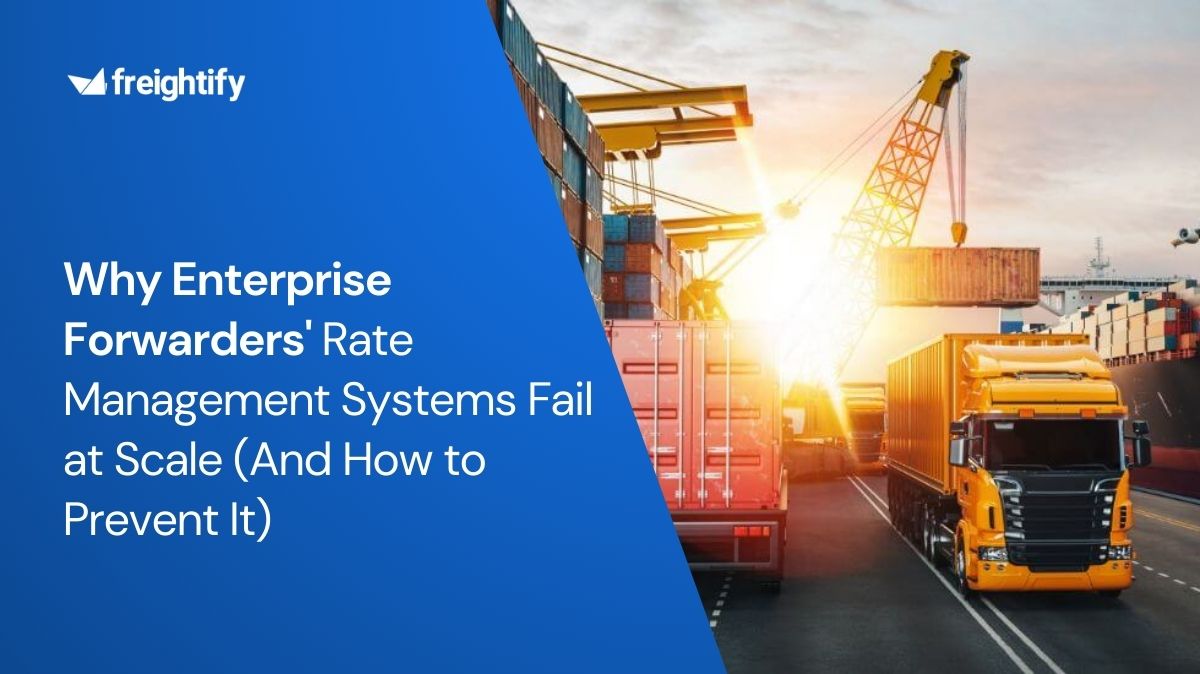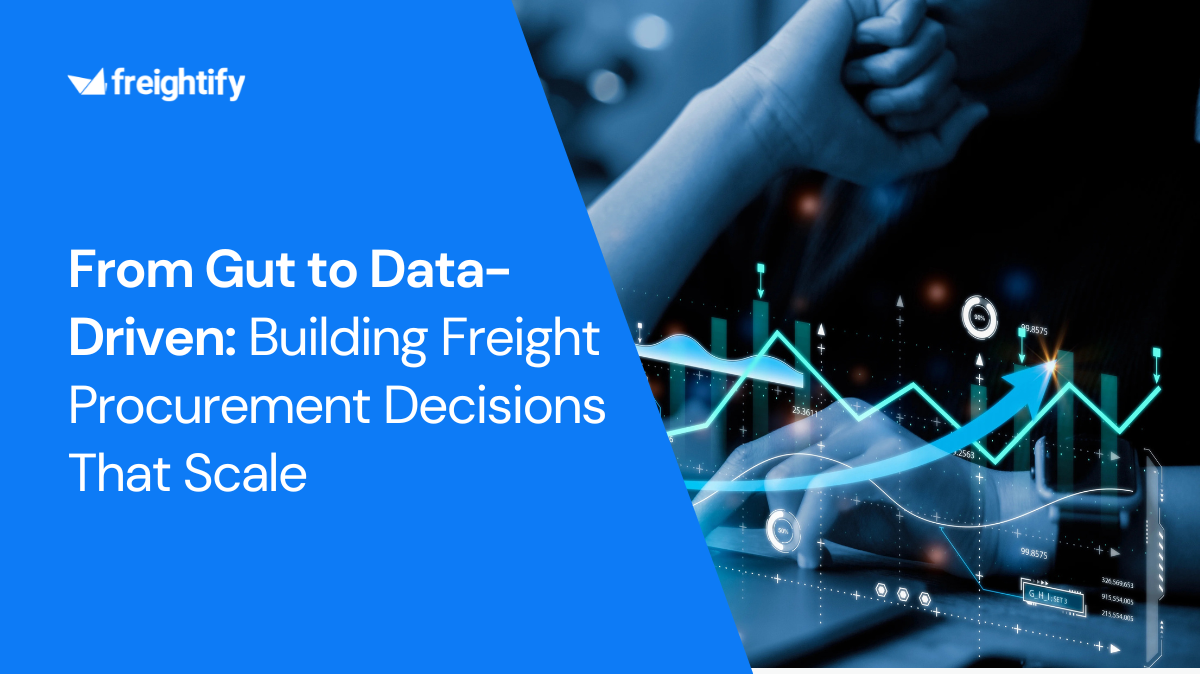The shipping and logistics industry has changed drastically as globalization and digitalization have become mainstream. Real-time ocean freight visibility is becoming a critical cornerstone for shippers, freight forwarders, truckers, and other stakeholders in effective supply chain management.
More than ever, shippers are investing in real-time visibility platforms and tools to streamline their operations. Billions of dollars are being spent on fine-tuning these tools so that companies can integrate real-time data with their freight and provide highly accurate ETAs.
What is ocean freight visibility? Ocean freight visibility provides real-time tracking and estimated arrival times for your cargo, allowing importers, exporters, manufacturers, and logistics professionals to optimize their supply chain. This translates into significant benefits such as reduced costs, improved customer satisfaction, and mitigated risks.
For example, with ocean freight visibility, you can see if your shipment is experiencing delays at port and proactively inform your customers.
Let us help you with your journey
Procure, Manage and Quote freight prices (with ancillary charges) in under 2 minutes!
Why is real-time ocean freight visibility important? Ever wondered where your shipment is or when it will arrive? In the complex world of ocean freight, unpredictable delays can wreak havoc on your supply chain. This is where real-time ocean freight visibility comes in.
Real-time visibility provides a clear picture of your shipment's location and progress, allowing you to: Predict Delays: Anticipate potential issues and proactively inform customers, avoiding frustration and lost sales.Optimize Costs: Negotiate better rates with carriers based on accurate arrival times, leading to cost savings.Improve Customer Experience: Set clear expectations and deliver on promises, resulting in happier customers.Real-time data is particularly valuable for different stakeholders: Shippers: Imagine worrying about port berthing times and customs delays. Real-time visibility empowers you to track your cargo's progress, predict potential delays, and take proactive measures.Freight Forwarders: Struggling to manage complex logistics and changing rates? Real-time data keeps you informed and enables you to optimize routes, negotiate effectively, and ensure smooth cargo movement.Container Lines: Need to optimize loading/unloading schedules? Real-time visibility provides insights into arrival timings, allowing you to plan more efficiently and maximize container utilization.While traditional tracking methods offer a limited view, real-time ocean freight visibility offers a powerful solution for a smoother, more efficient supply chain.
What is the difference between traditional and real-time freight visibility data? Stakeholders dealing with freight need to look at the real-time flow of information from point to point as their cargo moves through the supply chain. But currently, based on traditional methods, carriers can offer information based on outdated information or data.
The traditional approach to freight visibility is about carrier-dependent milestones, which are data gleaned from the carrier company. Unfortunately, there tend to be logistics blindspots for all players involved, which can cause delays. For instance, when freight is transported on the road, cargo being transferred to a new vehicle can mean a delay of 1-2 days. But when it comes to best ocean freight, moving cargo from one ship to another could lead to a longer delay, upwards of 15 days.
It's also important to note that ocean shipments go through trans-shipping and may include multiple stopovers, so the journey is not just from Port to Port. In such a case, freight forwarders, shippers, and other stakeholders need to get real-time data on complete schedule visibility, including the in-between checkpoints, stopovers, and other transitions. Typically this means companies lack the proper visibility to know details about:
Where their inventory is located If carriers are providing the necessary service levels Inefficiencies and bottlenecks in the supply chain Finally, sea freight rates are determined by various factors, including the type of loads, port requirements (documentation), customs, additional costs, etc. Traditionally merchants might not get the best quote.
Without a real-time view of the status and position of their freight, supply chains remain inefficient. Operations are at a disadvantage, as managers do not know when to expect freight accurately, and stakeholders don't know if they pay the best rates.
Unlike this traditional data gathering mechanism, real-time visibility tools allow shippers, freight forwarders, and other stakeholders to gather highly reliable data independently, with or without carrier inputs. While 3PLs can address these needs with their transportation management systems and other software tools, a gap still needs to be bridged.
How can real-time ocean freight data be acquired? Real-time ocean freight data can be gathered using various digital tools and interconnected systems to speak to each other. IoT (internet of things) and big data analytics play a vital role. For instance, to get accurate ETAs, organizations use IoT data gathered from truckers and drivers , which helps them understand driving speed and timing, driver behaviour operating in traffic and congested areas, and more. All this data can be gathered through ELD (Electronic Logging Devices) that trucks are outfitted with. Drivers can also use mobile apps to log in to work hours, stops, and other such details.
When it comes to real-time ocean freight visibility , factors like wind speed, trans-shipping, stopovers, and more play a part in when the freight arrives at the destination port. This way, companies can gather relevant data from various sensors linked to cargo, containers, drivers, and vehicles or vessels to collect relevant information and predict their impact on the arrival times or ETAs.
Container lines and shippers can also track container movements to predict arrival timing at ports, offloading or onboarding time needed, and even street-turn opportunities. Freightify, a digital solution, can help you benchmark the best rates, instant quotations and handle rate management for your FCL and LCL freight. This software excels at rate management , allowing you to plan effectively.
Why is this real-time data important to freight forwarders and shippers? The characteristics listed below are the advantages of this data's real-time visibility, which directly result in enhanced supply chain visibility:
Granularity : These are physical data sometimes at the package level and give access to real-time geolocation and shipping conditions (temperature, humidity, shocks, intrusions, movement such as craning) and shipment status. They answer questions like - is the container on a certain vessel, where is the vessel right now, and more. Automation : These data are automatically and continuously generated at the package level with no third-party intervention. Data transmission is also automated. They provide information on questions like - "What is the condition of cargo in transit?" or "Has the cargo been tampered with?" Real-time : Tracking updates are continuously transmitted. Moreover, shipping events or incidents detected by sensors generate alerts as soon as they occur, and these alerts are immediately sent through the IoT network. This allows managers and shippers to answer questions like whether the vessel has left Port or departure, whether the container has been transshipped, the best rates for transporting data from Port to the warehouse, and more. Agnostic : The data is generated independently from the shipping solution or carrier along the shipment journey. This independence from carriers is a key advantage for shippers who benefit from enhanced and direct visibility over their goods in transit and their supply chain. End-to-end : The tracking devices are with the goods; the visibility is door-to-door and not just between ports as most data-only tracking solutions. This allies shippers to know if the vessel has reached the Port of destination, has the vessel has been berthing for some time, and other vital details. Instances of how real-time ocean freight visibility create competitive advantages Gathering real-time ocean freight data for the shipping industry can be used to make decisions in the future to predict and avoid costly problems and create more reliable cargo delivery options. Here are a few instances of how data can be used to improve overall supply chain operations.
1. Shippers and freight forwarders can better coordinate to improve efficiency Shippers and freight forwarders always look for the best rates to transport cargo for themselves and their clients. Finding the correct ship and getting the right rates are dependent on various factors, including vessel ETAs and container availability.
Real-time ocean freight data availability can provide decision-makers with accurate, actionable information. Shippers can utilize automated systems, including transportation management and freight management portals, to estimate arrival time, vessel particulars, market information, and more. Further, using an exchange portal integrated into such systems, shippers can find freight forecasts, current rates, and available alternatives. This is an effective way to improve efficiency for forwarders and brokers.
An ocean freight API integration like Freightify LINK can be the linchpin to getting all this information in real-time. LINK is Freightify's API product , which helps retrieve the rate schedule information through an API into your existing system. Some of the benefits of using an API integration like LINK include:
Instant live rates of shipping liners and offline contract rates in real-time, A single format to consume for the contract sheet rates and live rates of different liners Easy integration with existing systems Reduction in the time to go to market 2. Improve ship operations and functioning Operating a ship to its optimum speed and function is also a challenge. Factors like engine wear, maintenance, etc., determine the longevity of a vessel. Real-time data visibility allows shippers to determine the best speed, fuel consumption, etc., while also considering freight rates, freight spot rates and schedules.
Apart from this, analyzing data gathered over a period of time can help carriers and shippers do a cost-benefit analysis to determine vessel maintenance, fuel consumption, and performance-related upgrades. This leads to a greater return on investment for carriers and other stakeholders who benefit from better-managed vessels with optimal performance.
3. Shippers, freight forwarders, and port authorities can optimize operations based on ETAs Shippers, carriers, freight forwarders, and other authorities need everything from ETAs to cargo information. Dashboards and transportation management systems can be used to track these factors in real-time instead of relying on emails and other notification methods much more efficiently.
With real-time information and data visibility, decisions like berthing, cargo handling, and route tracking can be more transparent. These tools also provide information on discrepancies. The ideal routes, routes provided by weather services, and the actual route taken by the vessel can all be tracked in real-time to find the best option. This ensures that the smallest changes to the ETA are tracked and accounted for, which helps companies manage costs more effectively.
Advantages of real-time data visibility in ocean freight 1. Reduce shipping costs through enhanced data or information visibility Real-time visibility is an extremely important tool for freight forwarders, shippers, and brokers. It allows them to get an accurate look at the market dynamics. As we saw in 2020, freight market dynamics can fluctuate rapidly. Depending on international trade and available routes, especially when rerouting shipments are involved, it's important to get real-time visibility to the satisfaction of consumers. This also affects last-mile delivery.
Today's successful shipper or freight forwarder needs to offer competitive ocean freight spot rates and maximize profits by effectively using supply chain or freight management software.
2. Data visibility is becoming a major tool of differentiation in the new era of supply chain Flexible, agile supply chains and logistics networks that are ready to pivot when required with the right digital and IoT tools are most competitive today. These adaptive processes see into the future with predictive analysis and robust algorithms.
To stand out amidst such robust operations, businesses need a competitive advantage. One of the methods that provide this advantage is real-time data visibility.
While 3PLs are serving the market with digital tools and IoT or AI solutions, there is still an IT gap that needs to be bridged. A recent study quizzed researchers and found that this IT gap remains static, and 94% of shippers agree that IT capabilities are necessary for 3PL expertise. Investing in real-time data visibility tools can be a positive step for stakeholders.
Importance of data in sea freight- tracking ROIs with supply chain visibility Sea freight tracking provides networks with the ability to view their cargo in real-time, predict accurate ETAs and solve problems that might arise. This is a surefire way to get robust ROIs on your visibility investments.
In conclusion, supply chain stakeholders, leaders, shippers, and forwarders can add more value to their operations by utilizing a real-time freight data system in their software suite. To this end, the need of the hour is investing in integrations that help you acquire and analyze real-time data and gain visibility into everything from container tracking to rate management. This can help companies and individual players gain the competitive edge to make more insightful decisions and better top and bottom lines.




















